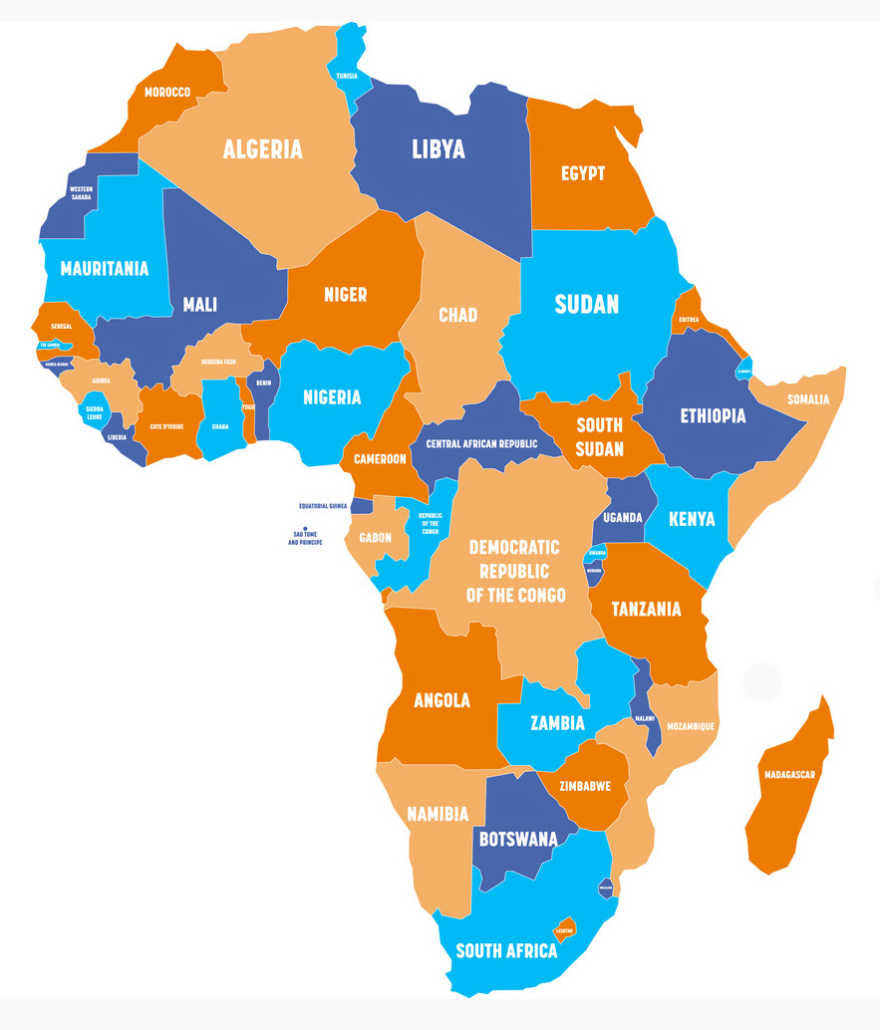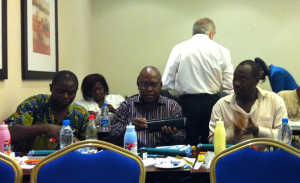Industry Eyes Turn to Africa
Industry Eyes Turn to Africa

Why are many industry eyes, the leading players in our printing supplies industry starting to look at Africa?
Having spent all my professional career working with and in Africa, I have recently seen a general increase in companies starting to take a renewed interest in the African markets.
Historically, many have seen the continent as being too complicated, too small or too scary to take any significant interest.
But Africa is changing rapidly and recently six of the world’s top ten fastest-growing economies (non-commodity based) were listed on the continent: Rwanda at 8.7 %, Ethiopia 7.4 %, Ivory Coast 7.4 %, Ghana 7.1 %, Tanzania 6.8%, and Benin 6.7 %.
According to market insights, Africa’s overall economic growth was at 3.4% in 2019 and was expected to reach 3.9% in 2020 and 4.1 % in 2021, continuing the continent’s consistent growth. Obviously, the pandemic and subsequent lockdowns will certainly change some of these numbers.
 Industry Eyes Turn to Africa Growth:
Industry Eyes Turn to Africa Growth:
- Rwanda: GDP Growth 8.7% Despite its relatively small size, Rwanda fights well above its weight in the regional economies. Accountable politics and inclusive economic institutions are driven by an open-minded government creating and driving policies to attract foreign direct investment and help promote new business.
- Ethiopia: GDP Growth 7.4% State-led drive to boost the manufacturing sector and establishment of industrial parks to attract foreign investment. Growth is expected to average 7.0% up to 2024.
- Ivory Coast: GDP Growth 7.4% The service sector, industrial activity along with strong agricultural and construction activity driving the growth and public works. Strong private investment will be fuelled by government policies to attract increased foreign investment.
- Ghana: GDP Growth 7.1% Increased private consumption fuelled by improvements in the macro-economic environment is consistently driving domestic demand. The industrial sector’s annual growth exceeded 10% for the past three years with government policies in place to continue supporting local industry output.
- Tanzania: GDP Growth 6.8% Political stability, strong economic governance, strategic location and diversified economy are all driving strong private consumption. Additional and continued reforms will continue to facilitate the general business environment and growth opportunities.
- Benin: GDP Growth 6.7% Strong public investment, the construction industry and agricultural sector (notably cotton) are driving growth.
- Senegal: GDP Growth 6.7% Government policies, notably the Plan Senegal Emergent (PSE) is supporting the diversification of the economy. The second phase of PSE is expected to boost private investment significantly, sustaining increased exports with the service sector being the main contributor to sustained growth.
Two other countries are worth mentioning since their economic forecast are also above the continent’s average, with Kenya at 6.1% and Uganda at 6.0% forecast GDP growth. Combined with the other countries in the region this highlights East African as particularly interesting.
 It can be said that geo-political and social stability has helped significantly in promoting many of these countries as “open for business”. Many of the countries had suffered decades of horrendous mismanagement and despot rulers who would do virtually anything to stop the advancement of their people and hang on to power for as long as possible and at any cost. Tribalism and the occasional coup or war doesn’t help.
It can be said that geo-political and social stability has helped significantly in promoting many of these countries as “open for business”. Many of the countries had suffered decades of horrendous mismanagement and despot rulers who would do virtually anything to stop the advancement of their people and hang on to power for as long as possible and at any cost. Tribalism and the occasional coup or war doesn’t help.
Dictatorships are no longer the “norm” and there has been a move to a more democratic society. This is, in part, due to the demise of the “Cold War” mentality but more importantly by the massive increase in the younger population who did not grow up under the shadow of a dictator.

The younger generation has access to the internet and the free flow of information, something their parents never had. As an example, in 1986 the only way to send a message from the Virunga National Park (Eastern DRC) was through a hollow log and getting a ‘drummer’ to bang out the message to the next village… and wait two or three days for a reply. In a recent visit, I noticed even the porters had at least one cell phone. This open access to information has made everybody far more aware of what is happening in other countries and enables people to compare their lives to others.
In addition to this newfound access to information, there are many diasporas who were forced to leave their countries either because of tribal, political or social-economic reasons. There are very few I met historically who were not desperate to return home.
The realization that the ‘developed’ world is not actually the nirvana it was made out to be, and the fact that their countries of origin were finally beginning to find their feet and offer a stable environment to return to, offered the excuse many were waiting for – returning home! The influence these returning citizens have made to the overall drive and growth in some of these territories cannot be under-estimated.
These elements combined offer a far more stable and secure economic environment. So much so that some of the ‘old school’ international institutions have started to ‘forgive’ many of the historical eccentricities of the past and started to take an interest in investing in new infrastructure projects. But it must be said, China was the first to recognize the change in many of the countries and were the first to invest, much to the chagrin of many in the West.
All of this results in a far greater economic certainty for many African countries and potentially a much brighter future. This stability has often been accompanied by economic reform, which has allowed the emergence of a wealthy elite as well as a ‘consumer class’ having regular jobs and who obviously look to spend their hard-earned salaries on items their parents could never have imagined. All of this has driven massive urbanization in many cities and with so many new businesses opening, there is a clear increase in the need for professional imaging hardware and supplies.
The result of this newfound confidence and relative security is population growth!
Africa is powered by more than a billion people and the continent has some of the youngest and fastest-growing populations in the world, in stark contrast with the populations of Japan, North America and Western Europe. This young population represents an important resource for Africa where around 40% of the world’s under-18s will be in Africa by 2050, according to Unicef.
 Obviously, this population will have a desire to ‘consume’ and will increase considerably the disposable incomes available. This, in turn, will drive the growth and the demand for new products and services.
Obviously, this population will have a desire to ‘consume’ and will increase considerably the disposable incomes available. This, in turn, will drive the growth and the demand for new products and services.
Moreover, the economic growth in Africa naturally leads to a consumer shift towards higher quality products, stemming from their new buying power. This is therefore seen again as a fresh market for imaging companies who have been reaching a point of saturation with business in the developed world. The drive to open borders to free trade between most African countries, who have signed up for the ‘African Continental Free Trade Area’, leads the new Pan-African economic vision to ensure free movement of goods between African countries rather than today’s scenario where more goods are imported from outside the continent than actually cross internal borders. This will increase significantly the demand for locally available product and certainly drive the demand for items manufactured within the Free Trade Zone.
Conclusion
Yes, there is good reason to be excited by a market powered by more than one billion people living and working in the biggest free trade zone ever.
This opportunity comes with many challenges but once you understand the complexities and subtleties there is a decision to be made: do I take up the challenge or not?
We all know it takes many years to gain the confidence and generate a reputation in a marketplace. But only when you finally learn you have been given an ‘African’ name you know you might be getting somewhere…
RT Media is partnering with Stuart Lacey to bring suppliers and buyers together in Africa at VIP Expo events. For further updates and contact information keep in touch on this webpage.
Related:
Comment:
Industry eyes turn to Africa. Do you have your eyes on Africa? Despite being too complicated in the past it now hosts six of the world’s top ten fastest-growing economies. Add your comments below or join the LinkedIn conversation.












Leave a Comment
Want to join the discussion?Feel free to contribute!